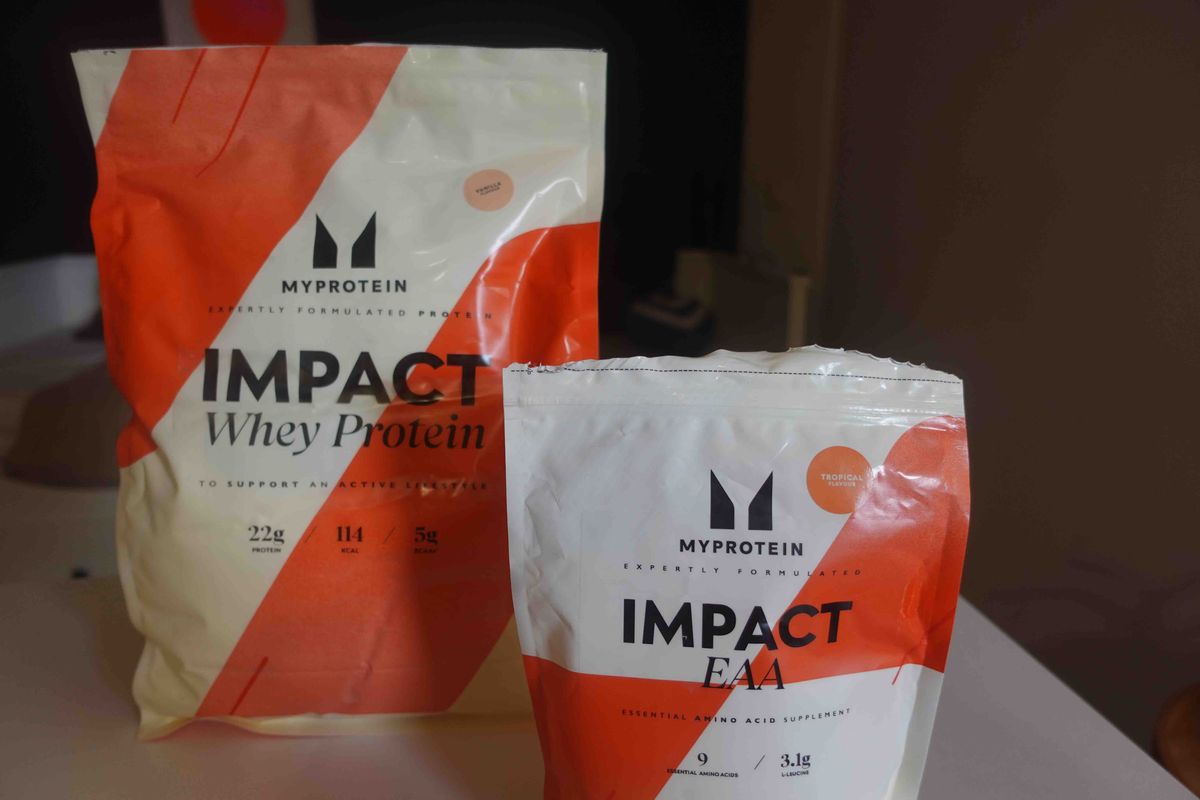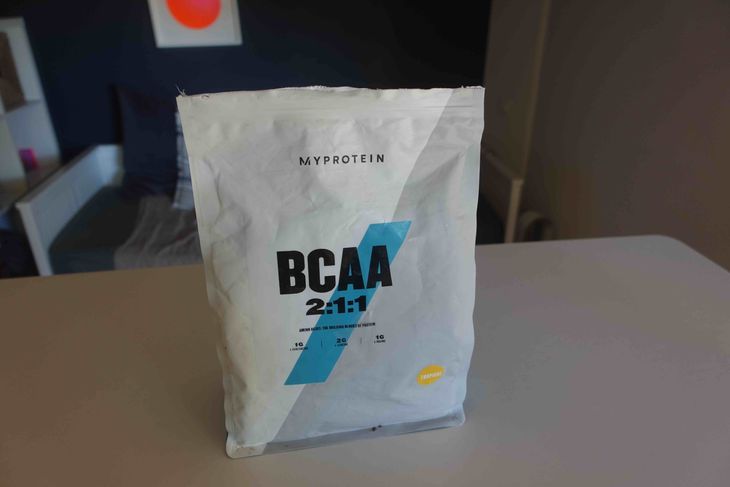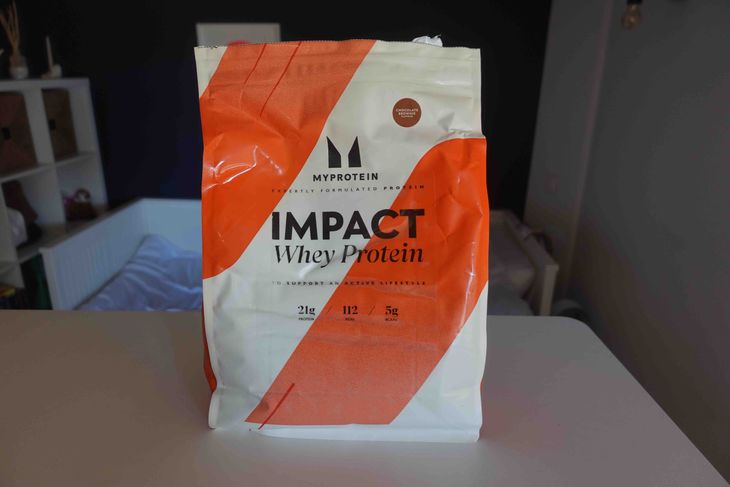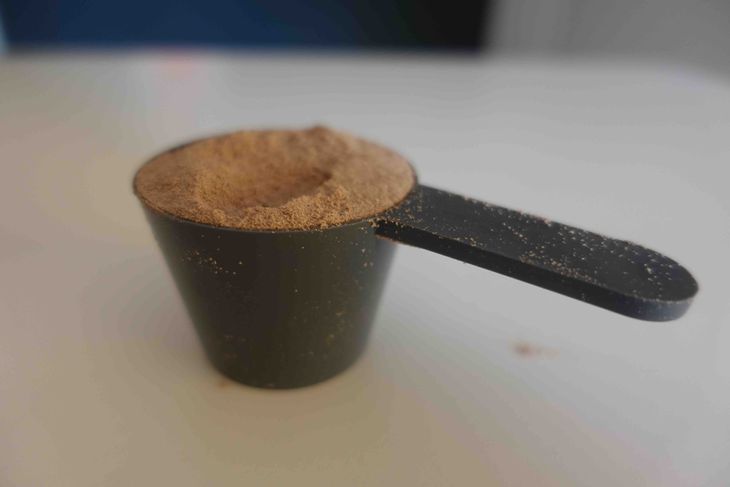Essential Amino Acids (EAAs) vs Whey Protein Powder

As a long-time lifter and ultra runner, I use whey protein every day and take essential amino acid supplements during workouts.
Since whey is a complete protein source, it contains all essential and non-essential amino acids (1). Nevertheless, as discussed in my article comparing egg and whey protein, the levels of certain essential amino acids (EAAs; e.g., phenylalanine, tryptophan) are quite low in whey protein. Additionally, while protein supplements provide you with intact protein (i.e., complex molecules comprised of many individual amino acids), EAA supplements provide free-form EAAs (i.e., amino acids not bound up in complex protein molecules), which may facilitate their digestion. Hence, it may be worth taking an EAA supplement in addition to whey protein.
Below, after an overview of the available supplements, we'll take a quick look at the evidence on how protein and EAAs can support muscle building, increase strength, repair muscle tissue, and promote lean mass.
Protein Supplements
As whey protein is the most widely used protein supplement, the protein-focused studies I've outlined below look at whey protein. However, it's possible to substantially increase protein intake by using powders based on plant protein:
Calories and Macronutrients in 100 Grams of Plant-Based Protein Powders From Optimum Nutrition, Sevenhills, Myprotein and Bodybuilding Warehouse
| Supplement | Calories | Protein | Carbs | Fats |
| Optimum Nutrition Plant Blend (Amazon) | 399 | 73 | 6.7 | 7.6 |
| Sevenhills Organic Raw Hemp (Amazon) | 349 | 48 | 7.4 | 9 |
| Sevenhillls Organic Pea (Amazon) | 381 | 84 | 1.1 | 4.5 |
| Sevenhills Organic Rice Powder (Amazon) | 398 | 84 | 6.9 | 3.1 |
| Bodybuilding Warehouse Pea Protein Isolate (Amazon) | 395 | 80 | 3 | 6 |
| Myprotein Pea Protein Isolate (Amazon) | 388 | 80 | 2.6 | 5.5 |
| Bodybuilding Warehouse Soy Protein Isolate (Amazon) | 368 | 90 | 6 | 1 |
| Myprotein Soy Protein Isolate (Amazon) | 360 | 90 | 1.8 | 1.5 |
| Pure Hemp 50 (Amazon) | 406 | 47 | 16.0 | 13.0 |
| Myprotein Rice Protein Powder | 423 | 78 | 3.8 | 2.1 |
| Myprotein Vegan Protein Blend (Amazon) | 366 | 71 | 11.0 | 2.5 |
| Bodybuilding Warehouse Vegan Blend (Amazon) | 337 | 71 | 6.5 | 2.5 |
As discussed in my articles comparing soy and pea protein, hemp and pea protein, rice and pea protein, and hemp and whey protein, there's also lots of evidence that plant-based powders can help you gain muscle, develop strength, and improve your body composition.
If you'd prefer to stick with a milk-based powder, there are lots of options, all with slightly different macronutrient profiles:
Calories and Macronutrients in 100 Grams of Milk-Based Protein Powders From Optimum Nutrition, Myprotein, Grenade, and Bodybuilding Warehouse
| Supplement | Calories | Protein | Carbs | Fats |
| Optimum Nutrition Whey Concentrate (Amazon) | 378 | 79 | 5.6 | 4.2 |
| Optimum Nutrition Whey Isolate (Amazon) | 366 | 83 | 4.5 | 1.4 |
| Optimum Nutrition Casein Powder (Amazon) | 350 | 74 | 5.8 | 2.5 |
| Myprotein Whey Concentrate (Amazon) | 405 | 77 | 8.3 | 7.1 |
| Myprotein Whey Isolate (Amazon) | 359 | 81 | 4.6 | 1.1 |
| Myprotein Diet Whey (Amazon) | 349 | 61 | 13 | 4.1 |
| Myprotein Total Protein | 388 | 81 | 4.4 | 4.9 |
| Myprotein Casein Powder | 350 | 82 | 4.7 | 1.2 |
| Grenade Whey Protein (Amazon) | 370 | 78 | 1.9 | 1.8 |
| Bodybuilding Warehouse Whey Concentrate (Amazon) | 375 | 80 | 4.7 | 5.7 |
| Bodybuilding Warehouse Whey Isolate (Amazon) | 374 | 90 | 1.0 | 1.0 |
| Bodybuilding Warehouse Pure Casein | 375 | 78 | 13.1 | 1.1 |
| Bodybuilding Warehouse Casein Hydrolysate | 320 | 85 | 0 | 0 |
As you can see, most milk-based protein powders use whey protein, though some use casein protein. Check out my article comparing whey and casein proteins to learn about their similarities and differences. For instance, you'll find a graph comparing these proteins in terms of their EAA concentrations.
If you're not into protein shakes, you could increase your protein intake with protein bars. Here are some of the bars offered by Myprotein:
Calories and Macronutrients in 100 Grams of Milk-Based Protein Bars From Myprotein
| Supplement | Calories | Protein | Carbs (Sugar) | Fats |
|---|---|---|---|---|
| Layered Protein Bar (Amazon) | 354 | 33 | 34 (3.2) | 10 |
| Impact Protein Bar (Amazon) | 357 | 31 | 32 (3.1) | 13 |
| Crispy Layered Bar (Amazon) | 353 | 27 | 37 (3.5) | 15 |
| Protein Break Bar | 526 | 16 | 37 (4.2) | 39 |
| Breakfast Layered Bar | 423 | 26 | 32 (5.4) | 21 |
And here are some of the bars offered by Grenade:
Calories and Macronutrients in 100 Grams of Milk-Based Protein Bars From Grenade
| Supplement | Calories | Protein | Carbs (Sugar) | Fats |
|---|---|---|---|---|
| Oreo Protein Bar (Amazon) | 389 | 35 | 34 (1.7) | 17 |
| Chocolate Chip Cookie Dough Bar (Amazon) | 353 | 34 | 34 (2.5) | 13 |
| Peanut Butter and Jelly Bar (Amazon) | 384 | 34 | 33 (3.0) | 17 |
| Fudged Up Protein Bar (Amazon) | 387 | 34 | 29 (2.8) | 17 |
| White Chocolate Salted Peanut Bar (Amazon) | 403 | 33 | 32 (2.5) | 20 |
If you'd like to avoid dairy products or animal proteins, check out these plant-based options.
Calories and Macronutrients in 100 Grams of Plant-Based Protein Bars From Myprotein
| Supplement Type | Calories | Protein | Carbs (Sugar) | Fats |
|---|---|---|---|---|
| Vegan Carb Crusher (Amazon) | 394 | 27 | 31 (3.0) | 17 |
| Pea-Nut Square | 466 | 24 | 27 (17) | 27 |
| Vegan Double Dough Brownie (Amazon) | 403 | 21 | 42 (8.3) | 15 |
| Vegan Gooey Filled Cookie | 330 | 18 | 49 (4.0) | 11 |
You might also be interested in my article comparing protein bars and powders.
EAA Products
Popular EAA supplements include:
- Love Life Supplements Essential Amino Acids (average rating: 4.50/5) – a apple and kiwi powder providing all of the essential amino acids.
- Impact EAA (average rating: 4.17/5) – a powder providing all essential amino acids (including lots of leucine), available in two flavours
- The EAA (average rating; 4.14/5) – a powder providing all essential amino acids (including lots of leucine) and with additional vitamins and minerals, available in four flavours
- The EAA Sample (average rating; 3/5)– as above, but a small and very inexpensive sample
- My Vegan EAA (average rating: 4.17/5) – a vegan powder providing all essential amino acids (including lots of leucine), available in a couple of flavours
There's extensive evidence that branched-chain amino acids (BCAAs) can enhance athletic performance. The BCAAs—isoleucine, leucine, and valine—are a subset of EAAs (the remaining EAAs are histidine, lysine, methionine, phenylalanine, threonine, and tryptophan).

My current bag of BCAA powder. You can get an unflavoured version if you want to avoid artificial sweeteners, but I use the tropical-flavoured one as it makes water more appealing.
Popular BCAA supplements include:
- Optimum Nutrition Gold Standard BCAA Powder (average rating: 4.60/5) – raspberry and pomegranate BCAA powder with vitamin C, electrolytes, and zinc
- Essential BCAA 2:1:1 Powder (average rating: 4.18/5) – a powder providing leucine, isoleucine, and valine in a 2:1:1 ratio, available in various flavours
- Essential BCAA 4:1:1 Powder (average rating: 4.29/5) – as above, but with a 4:1:1 ratio
- Vegan BCAA Powder (average rating: 4.36/5) – a vegan powder providing leucine, isoleucine, and valine in a 2:1:1 ratio, available in "unflavoured"
- Vegan BCAA Sustain Sample (average rating: 4.60/5) – a small and very inexpensive sample providing leucine, isoleucine, and valine in a 2:1:1 ratio, available in various flavours
You might also be interested in my articles comparing EEA supplementation and BCAA supplementation and comparing BCAA in powder form to pills.
Muscle Growth
Protein and amino acid supplementation can promote an anabolic response in skeletal muscle and facilitate lean mass growth (2).
Protein Powder
In one study (3), resistance-trained males received either creatine with carbohydrate (CrCHO), creatine with whey protein (CrWP), whey protein alone (WP), or carbohydrate alone (CHO) and underwent an 11-week resistance training programme. The CrCHO, WP, and CrWP groups experienced significantly greater improvements in skeletal muscle development than the CHO group.

My current bag of whey protein concentrate. I'm not sure I'd get the chocolate brownie flavour again as it has a little less protein than others (69 grams per 100 compared to 80 grams in vanilla, for example), but it tastes amazing in porridge with peanut butter, cinnamon, and seeds.
EAAs
In research evaluating the impact of EAA supplements during the early stages of a heavy-load training programme, 29 young males were assigned to either a placebo or an EAA group for 12 weeks (4).
The 15-gram EAA supplement was composed of 11% histidine, 10% isoleucine, 19% leucine, 15% lysine, 3% methionine, 15% phenylalanine, 15% threonine, and 12% valine. While both groups exhibited notable gains in muscle mass, the enhancements were more significant in the EAA group.
Such effects may be due to EAA supplements contributing to the development of new muscle protein and their role in minimising muscle protein breakdown (5).
Muscle Strength
Protein Powder
One study found that recreational bodybuilders consuming 1.5 grams of whey protein per kilogram of body weight daily during a 10-week resistance training regimen saw substantial improvements in strength, as measured by their one-repetition maximum in bench press, squats, and cable pull-down (6).
EAAs
In another study, twenty-four participants were split into two groups for a three-day workout regimen; one group received a daily dose of 6.6g of EAA mixed with Gatorade, while the other just received Gatorade in a double-blind arrangement (7). Those in the EAA group saw more substantial improvements in strength and enhanced their performance in sprint and run exercises.
Muscle Repair
Protein Powder
Research published in Nutrients (8) demonstrated that consuming whey protein after exercising decreases protein degradation and can enhance maximal strength, the number of repetitions until failure, and peak power 24 hours after physical activity, suggesting that whey protein is beneficial for muscle repair and recovery following intense exercise.

Up close and personal with a scoop of chocolate-brownie-flavoured whey protein concentrate.
EAAs
In a controlled, double-blind, randomised crossover study (9), ten untrained male participants undertook elbow flexion and extension activities and were administered either a placebo or leucine-enriched essential amino acid (LEAA) supplements thrice daily over a week. There was a significant decrease in serum creatine phosphokinase (CPK) activity, an indicator of muscle damage, in those taking the LEAA supplement, suggesting that it may help reduce muscle damage and aid recovery after exercise.
Body Composition
Protein Powder
One study found that participants gained significant lean muscle mass following a 12-week resistance training programme combined with a daily intake of 19 grams of whey protein isolate (10).
EAAs
In a double-blind, placebo-controlled experiment (11), older adults were administered either a placebo or a daily dose of 15 grams of EAAs for three months. The findings indicated that EAA supplementation immediately stimulated muscle protein synthesis and resulted in a rise in lean body mass and a sustained increase in muscle protein synthesis over a three-month duration.
Athletic Performance
Protein Powder
One systematic review of 38 research studies assessed the effect of whey protein on enhancing athletic performance when combined with resistance training (12). It found that protein supplementation could significantly promote muscle hypertrophy, strength gains, and aerobic and anaerobic power, contributing to better overall athletic performance.
EAAs
A study in Taiwan (13) found that national-level endurance runners achieved
significantly faster times in a 5,000-meter run
(average time: 17 minutes, 45 seconds) when they consumed EAAs one hour before running, as opposed to taking a placebo (average time: 18 minutes, 20 seconds). Similarly, their performance improved over 10,000 meters with EAA supplementation (average time: 34 minutes, 52 seconds) compared to when they took a placebo (average time: 36 minutes, 15 seconds). This may reflect EAAs contributing to energy production (5)
Overall Health
EAA supplements, as well as protein supplements that contain EAAs, may have many health benefits in addition to those related to athletic performance:
- EAAs play a crucial role in supporting immune function by aiding in the production of antibodies and immune system cells, with studies indicating that supplementation can enhance immune responses (14).
- Furthermore, amino acids such as tryptophan are precursors to serotonin and melatonin, suggesting that supplementation could improve mood and sleep quality (15).
- Additionally, amino acid supplements can improve metabolic health by aiding in the regulation of blood sugar levels, thus offering potential benefits for individuals with diabetes or metabolic syndrome (16).
- Amino acid supplements, particularly those containing glutamine, can promote the health of the digestive system by enhancing the integrity of the gut barrier (17).
EAAs vs Protein Powder: What's the Best Option?
The answer to this depends on your goals and diet, as different amino acids are linked to various outcomes, and each person's diet will have different amounts of certain amino acids.
However, if I had to choose, I would choose a whey protein powder over an essential amino acid supplement. One reason is that whey protein provides a lot of leucine, and there's extensive evidence linking this EAA to increased muscle protein synthesis (18, 19) and enhanced endurance and power (20). Yes, you could get more leucine from an EAA, but a single scoop of whey protein contains as much leucine as is typically administered to participants in studies in which positive athletic outcomes are observed. A second reason for choosing whey protein is that it contains important non-essential amino acids.
For instance, serine can increase perceived energy levels during exercise (21), and cysteine can minimise muscle breakdown following workouts (22).
What's the Best Time to Take EAAs and Protein Powder?
Research featured in The Journal of Sports Medicine and Physical Fitness indicates that consuming EAAs post-exercise is more effective at reducing muscle soreness than taking them beforehand (23).
A study published in the Journal of Exercise Rehabilitation (24) found that the timing of whey protein intake, whether before, after, or both, did not significantly impact muscle recovery or damage indicators.
However, as amino acid levels in the blood return to baseline within 2–3 hours of consuming protein (25), it's common for people focused on building muscle to consume high-protein meals every few hours.
How Much is Enough Protein?
According to the Mayo Clinic, those engaged in resistance training or preparing for endurance events should aim for 1.2 to 1.7 grams of protein per kilogram of body weight per day.
Therefore, a 70-kg person (about the average weight of a woman in the UK) would aim for 84 to 119 grams, whereas an 85-kg person (about the average weight of a man in the UK) would aim for 102 to 145 grams. Eighty-four grams is about four scoops of whey protein concentrate, while 145 grams is about seven scoops. However, it would be best if you aimed to get a substantial amount of your protein from food sources that contain other nutrients. Lean meats like chicken and turkey are high-quality protein sources, providing over 30 grams of protein per 100 grams of leg or breast meat.
Plant-based sources of protein recommended by the American Heart Association include beans, seeds, chickpeas, nut butters (e.g., peanut butter, cashew butter, almond butter), peas, tempeh, and tofu.
Conclusion
Thus, numerous studies indicate that the benefits of EAAs and dietary protein include an increase in anabolic rate, the development of new muscle tissue, and enhanced strength, muscle repair, and body composition.
Since you're interested in protein powders and other dietary supplements, you might like one of these articles:
- Comparing glutamine and creatine
- Comparing collagen and whey protein
- Comparing whey protein and creatine
- Comparing whey protein and pea protein
- Comparing mass gainers and protein powders
- Comparing BCAAs and beta-alanine
- Comparing whey, pea, and soy protein powders
- The best protein supplements for weight loss
- The best protein supplements for weight gain
- The best protein supplements for diabetics
- The best protein supplements for seniors
- The best muscle-enhancing supplements for older adults
- The best muscle recovery supplements
- The best beta-alanine supplements
- The best amino acid supplements for bodybuilders
About the Author
Dave Robinson, a co-founder of ukfitness.pro, has a background in psychology (BSc) and neuroscience (MSc, PhD). As well as strength training, he enjoys endurance challenges and has run ultramarathons, cycled across several countries, and completed the Three Peaks Challenge. When writing, he draws on scientific evidence to understand the pros and cons of different diets, supplements, and training regimes.
As an Amazon Associate, the site earns from qualifying purchases.

References
1. Rasmussen, C.J. (2008). Nutritional Supplements for Endurance Athletes. In: Nutritional Supplements in Sports and Exercise. Humana Press. https://doi.org/10.1007/978-1-59745-231-1_11
2. Reidy, P. T., & Rasmussen, B. B. (2016). Role of Ingested Amino Acids and Protein in the Promotion of Resistance Exercise-Induced Muscle Protein Anabolism. The Journal of nutrition, 146(2), 155–183. https://doi.org/10.3945/jn.114.203208
3. Cribb, P. J., Williams, A. D., Stathis, C. G., Carey, M. F., & Hayes, A. (2007). Effects of whey isolate, creatine, and resistance training on muscle hypertrophy. Medicine and science in sports and exercise, 39(2), 298–307. https://doi.org/10.1249/01.mss.0000247002.32589.ef
4. Vieillevoye, S., Poortmans, J. R., Duchateau, J., & Carpentier, A. (2010). Effects of a combined essential amino acids/carbohydrate supplementation on muscle mass, architecture and maximal strength following heavy-load training. European journal of applied physiology, 110(3), 479–488. https://doi.org/10.1007/s00421-010-1520-9
5. Wolfe R. R. (2017). Branched-chain amino acids and muscle protein synthesis in humans: myth or reality?. Journal of the International Society of Sports Nutrition, 14, 30. https://doi.org/10.1186/s12970-017-0184-9
6. Cribb, P. J., Williams, A. D., Carey, M. F., & Hayes, A. (2006). The effect of whey isolate and resistance training on strength, body composition, and plasma glutamine. International journal of sport nutrition and exercise metabolism, 16(5), 494–509. https://doi.org/10.1123/ijsnem.16.5.494
7. Johnson, A., Szych, K., Gomez, A., Jackson, S., Rubio, A. A., Massey, S. A., Gomez, A., Juarez, L., & Barlow, M. A. (2018). Delayed Onset Muscle Soreness Attenuation by Acute Consumption of Essential Amino Acids. International Journal of Exercise Science: Conference Proceedings, 2(10), Article 100.
8. West, D. W. D., Abou Sawan, S., Mazzulla, M., Williamson, E., & Moore, D. R. (2017). Whey Protein Supplementation Enhances Whole Body Protein Metabolism and Performance Recovery after Resistance Exercise: A Double-Blind Crossover Study. Nutrients, 9(7), 735. https://doi.org/10.3390/nu9070735
9. Matsui, Y., Takayanagi, S., Ohira, T., Watanabe, M., Murano, H., Furuhata, Y., & Miyakawa, S. (2019). Effect of a leucine-enriched essential amino acids mixture on muscle recovery. Journal of physical therapy science, 31(1), 95–101. https://doi.org/10.1589/jpts.31.95
10. Lynch, H.M.; Buman, M.P.; Dickinson, J.M.; Ransdell, L.B.; Johnston, C.S.; Wharton, C.M. No Significant Differences in Muscle Growth and Strength Development When Consuming Soy and Whey Protein Supplements Matched for Leucine Following a 12 Week Resistance Training Program in Men and Women: A Randomized Trial. Int. J. Environ. Res. Public Health 2020, 17, 3871. https://doi.org/10.3390/ijerph17113871
11. Dillon, E. L., Sheffield-Moore, M., Paddon-Jones, D., Gilkison, C., Sanford, A. P., Casperson, S. L., Jiang, J., Chinkes, D. L., & Urban, R. J. (2009). Amino acid supplementation increases lean body mass, basal muscle protein synthesis, and insulin-like growth factor-I expression in older women. The Journal of clinical endocrinology and metabolism, 94(5), 1630–1637. https://doi.org/10.1210/jc.2008-1564
12. Pasiakos, S. M., McLellan, T. M., & Lieberman, H. R. (2015). The effects of protein supplements on muscle mass, strength, and aerobic and anaerobic power in healthy adults: a systematic review. Sports medicine (Auckland, N.Z.), 45(1), 111–131. https://doi.org/10.1007/s40279-014-0242-2
13. Cheng, I., Wang, Y., Chen, I., Hsu, G., & Hsueh, C. (2016). The supplementation of branched-chain amino acids, arginine, and citrulline improves endurance exercise performance in two consecutive days. Journal of Sports Science and Medicine, 15, 509–515.
14. Li, P., Yin, Y. L., Li, D., Kim, S. W., & Wu, G. (2007). Amino acids and immune function. The British journal of nutrition, 98(2), 237–252. https://doi.org/10.1017/S000711450769936X
15. Markus, C. R., Olivier, B., Panhuysen, G. E., Van Der Gugten, J., Alles, M. S., Tuiten, A., Westenberg, H. G., Fekkes, D., Koppeschaar, H. F., & de Haan, E. E. (2000). The bovine protein alpha-lactalbumin increases the plasma ratio of tryptophan to the other large neutral amino acids, and in vulnerable subjects raises brain serotonin activity, reduces cortisol concentration, and improves mood under stress. The American journal of clinical nutrition, 71(6), 1536–1544. https://doi.org/10.1093/ajcn/71.6.1536
16. Manders, R. J., Koopman, R., Sluijsmans, W. E., van den Berg, R., Verbeek, K., Saris, W. H., Wagenmakers, A. J., & van Loon, L. J. (2006). Co-ingestion of a protein hydrolysate with or without additional leucine effectively reduces postprandial blood glucose excursions in Type 2 diabetic men. The Journal of nutrition, 136(5), 1294–1299. https://doi.org/10.1093/jn/136.5.1294
17. Achamrah, N., Déchelotte, P., & Coëffier, M. (2017). Glutamine and the regulation of intestinal permeability: from bench to bedside. Current opinion in clinical nutrition and metabolic care, 20(1), 86–91. https://doi.org/10.1097/MCO.0000000000000339
18. Garlick P. J. (2005). The role of leucine in the regulation of protein metabolism. The Journal of nutrition, 135(6 Suppl), 1553S–6S. https://doi.org/10.1093/jn/135.6.1553S
19. Mobley, C. B., Fox, C. D., Ferguson, B. S., Pascoe, C. A., Healy, J. C., McAdam, J. S., Lockwood, C. M., & Roberts, M. D. (2015). Effects of protein type and composition on postprandial markers of skeletal muscle anabolism, adipose tissue lipolysis, and hypothalamic gene expression. Journal of the International Society of Sports Nutrition, 12, 14. https://doi.org/10.1186/s12970-015-0076-9
20. Crowe, M. J., Weatherson, J. N., & Bowden, B. F. (2006). Effects of dietary leucine supplementation on exercise performance. European journal of applied physiology, 97(6), 664–672. https://doi.org/10.1007/s00421-005-0036-1
21. Tsuda, Y., Yamaguchi, M., Noma, T., Okaya, E., & Itoh, H. (2019). Combined Effect of Arginine, Valine, and Serine on Exercise-Induced Fatigue in Healthy Volunteers: A Randomized, Double-Blinded, Placebo-Controlled Crossover Study. Nutrients, 11(4), 862. https://doi.org/10.3390/nu11040862
22. Tsakiris, S., Parthimos, T., Parthimos, N., Tsakiris, T., & Schulpis, K. H. (2006). The beneficial effect of L-cysteine supplementation on DNA oxidation induced by forced training. Pharmacological research, 53(4), 386–390. https://doi.org/10.1016/j.phrs.2006.01.008
23. Ra, S. G., Miyazaki, T., Kojima, R., Komine, S., Ishikura, K., Kawanaka, K., Honda, A., Matsuzaki, Y., & Ohmori, H. (2018). Effect of BCAA supplement timing on exercise-induced muscle soreness and damage: a pilot placebo-controlled double-blind study. The Journal of sports medicine and physical fitness, 58(11), 1582–1591. https://doi.org/10.23736/S0022-4707.17.07638-1
Kim, J., Lee, C., & Lee, J. (2017). Effect of timing of whey protein supplement on muscle damage markers after eccentric exercise. Journal of exercise rehabilitation, 13(4), 436–440. https://doi.org/10.12965/jer.1735034.517
Tang, J. E., Moore, D. R., Kujbida, G. W., Tarnopolsky, M. A., & Phillips, S. M. (2009). Ingestion of whey hydrolysate, casein, or soy protein isolate: effects on mixed muscle protein synthesis at rest and following resistance exercise in young men. Journal of applied physiology (Bethesda, Md. : 1985), 107(3), 987–992. https://doi.org/10.1152/japplphysiol.00076.2009